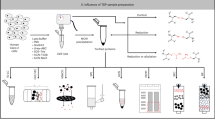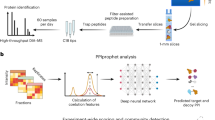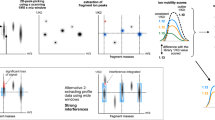Abstract
Top-down analysis of intact proteins and middle-down analysis of proteins subjected to limited digestion require efficient detection of traces of proteoforms in samples, necessitating the reduction of sample complexity by thorough pre-fractionation of the proteome components in the sample. SDS–PAGE is a simple and inexpensive high-resolution protein-separation technique widely used in biochemical and molecular biology experiments. Although its effectiveness for sample preparation in bottom-up proteomics has been proven, establishing a method for highly efficient recovery of intact proteins from the gel matrix has long been a challenge for its implementation in top-down and middle-down proteomics. As a much-awaited solution to this problem, we present an experimental protocol for efficient proteoform fractionation from complex biological samples using passively eluting proteins from polyacrylamide gels as intact species for mass spectrometry (PEPPI-MS), a rapid method for extraction of intact proteins separated by SDS–PAGE. PEPPI-MS allows recovery of proteins below 100 kDa separated by SDS–PAGE in solution with a median efficiency of 68% within 10 min and, unlike conventional electroelution methods, requires no special equipment, contributing to a remarkably economical implementation. The entire protocol from electrophoresis to protein purification can be performed in <5 h. By combining the resulting PEPPI fraction with other protein-separation techniques, such as reversed-phase liquid chromatography and ion mobility techniques, multidimensional proteome separations for in-depth proteoform analysis can be easily achieved.
Key points
-
Sample pre-fractionation is essential to reduce complexity before top- and middle-down proteomics. PEPPI-MS uses passive-elution from SDS–PAGE to recover proteins below 100 kDa. The workflow can be applied to intact proteins (top-down proteomics) or to partially digested proteins (middle-down proteomics). Analysis on size-selected fractions (targeted middle-down proteomics) is also possible.
-
This protocol uses standard electrophoresis equipment and reagents, reducing costs and easing barriers to implementation.
This is a preview of subscription content, access via your institution
Access options
Access Nature and 54 other Nature Portfolio journals
Get Nature+, our best-value online-access subscription
$32.99 / 30 days
cancel any time
Subscribe to this journal
Receive 12 print issues and online access
$259.00 per year
only $21.58 per issue
Buy this article
- Purchase on SpringerLink
- Instant access to full article PDF
Prices may be subject to local taxes which are calculated during checkout





Similar content being viewed by others
References
Aebersold, R. & Mann, M. Mass spectrometry-based proteomics. Nature 422, 198–207 (2003).
Smith, L. M. & Kelleher, N. L. Proteoforms as the next proteomics currency. Science 359, 1106–1107 (2018).
Schaffer, L. V. et al. Identification and quantification of proteoforms by mass spectrometry. Proteomics 19, e1800361 (2019).
Brown, K. A., Melby, J. A., Roberts, D. S. & Ge, Y. Top-down proteomics: challenges, innovations, and applications in basic and clinical research. Expert Rev. Proteom. 17, 719–733 (2020).
Su, T., Hollas, M. A. R., Fellers, R. T. & Kelleher, N. L. Identification of splice variants and isoforms in transcriptomics and proteomics. Annu. Rev. Biomed. Data Sci. 6, 357–376 (2023).
Drown, B. S. et al. Mapping the proteoform landscape of five human tissues. J. Proteome Res. 21, 1299–1310 (2022).
Adams, L. M. et al. Mapping the KRAS proteoform landscape in colorectal cancer identifies truncated KRAS4B that decreases MAPK signaling. J. Biol. Chem. 299, 102768 (2023).
Melani, R. D. et al. The Blood Proteoform Atlas: a reference map of proteoforms in human hematopoietic cells. Science 375, 411–418 (2022).
Compton, P. D., Zamdborg, L., Thomas, P. M. & Kelleher, N. L. On the scalability and requirements of whole protein mass spectrometry. Anal. Chem. 83, 6868–6874 (2011).
Tsiatsiani, L. & Heck, A. J. Proteomics beyond trypsin. FEBS J. 282, 2612–2626 (2015).
Sidoli, S. & Garcia, B. A. Middle-down proteomics: a still unexploited resource for chromatin biology. Expert Rev. Proteom. 14, 617–626 (2017).
Takemori, A. et al. GeLC-FAIMS-MS workflow for in-depth middle-down proteomics. Proteomics 24, e2200431 (2024).
Guo, Y., Cupp‐Sutton, K. A., Zhao, Z., Anjum, S. & Wu, S. Multidimensional separations in top–down proteomics. Anal. Sci. Adv. 4, 181–203 (2023).
Nickerson, J. L. et al. Recent advances in top-down proteome sample processing ahead of MS analysis. Mass Spectrom. Rev. 42, 457–495 (2023).
Laemmli, U. K. Cleavage of structural proteins during the assembly of the head of bacteriophage T4. Nature 227, 680–685 (1970).
Pflieger, D. et al. Systematic identification of mitochondrial proteins by LC-MS/MS. Anal. Chem. 74, 2400–2406 (2002).
Schirle, M., Heurtier, M. A. & Kuster, B. Profiling core proteomes of human cell lines by one-dimensional PAGE and liquid chromatography-tandem mass spectrometry. Mol. Cell. Proteom. 2, 1297–1305 (2003).
Takemori, A. et al. BAC-DROP: rapid digestion of proteome fractionated via dissolvable polyacrylamide gel electrophoresis and its application to bottom-up proteomics workflow. J. Proteome Res. 20, 1535–1543 (2021).
Takemori, A. et al. PEPPI-MS: polyacrylamide-gel-based prefractionation for analysis of intact proteoforms and protein complexes by mass spectrometry. J. Proteome Res. 19, 3779–3791 (2020).
Takemori, A. & Takemori, N. Sample preparation for structural mass spectrometry via polyacrylamide gel electrophoresis. Methods Enzymol. 682, 187–210 (2023).
Takemori, N. & Takemori, A. In-depth structural proteomics integrating mass spectrometry and polyacrylamide gel electrophoresis. Front. Anal. Sci. 2, 1107183 (2023).
Takemori, A., Kaulich, P. T., Cassidy, L., Takemori, N. & Tholey, A. Size-based proteome fractionation through polyacrylamide gel electrophoresis combined with LC-FAIMS-MS for in-depth top-down proteomics. Anal. Chem. 94, 12815–12821 (2022).
Le Maire, M., Deschamps, S., Møller, J. V., Le Caer, J. P. & Rossier, J. Electrospray ionization mass spectrometry on hydrophobic peptides electroeluted from sodium dodecyl sulfate-polyacrylamide gel electrophoresis application to the topology of the sarcoplasmic reticulum Ca2+ ATPase. Anal. Biochem. 214, 50–57 (1993).
Schuhmacher, M., Glocker, M. O., Wunderlin, M. & Przybylski, M. Direct isolation of proteins from sodium dodecyl sulfate-polyacrylamide gel electrophoresis and analysis by electrospray-ionization mass spectrometry. Electrophoresis 17, 848–854 (1996).
Shevchenko, A., Tomas, H., Havlis, J., Olsen, J. V. & Mann, M. In-gel digestion for mass spectrometric characterization of proteins and proteomes. Nat. Protoc. 1, 2856–2860 (2006).
Seelert, H. & Krause, F. Preparative isolation of protein complexes and other bioparticles by elution from polyacrylamide gels. Electrophoresis 29, 2617–2636 (2008).
Cohen, S. L. & Chait, B. T. Mass spectrometry of whole proteins eluted from sodium dodecyl sulfate-polyacrylamide gel electrophoresis gels. Anal. Biochem. 247, 257–267 (1997).
Claverol, S., Burlet-Schiltz, O., Gairin, J. E. & Monsarrat, B. Characterization of protein variants and post-translational modifications: ESI-MSn analyses of intact proteins eluted from polyacrylamide gels. Mol. Cell. Proteom. 2, 483–493 (2003).
Fulcher, J. M. et al. Enhancing top-down proteomics of brain tissue with FAIMS. J. Proteome Res. 20, 2780–2795 (2021).
Reed, B. D. et al. Real-time dynamic single-molecule protein sequencing on an integrated semiconductor device. Science 378, 186–192 (2022).
Leney, A. C. & Heck, A. J. R. Native mass spectrometry: what is in the name? J. Am. Soc. Mass Spectrom. 28, 5–13 (2017).
Zhou, M. et al. Higher-order structural characterisation of native proteins and complexes by top-down mass spectrometry. Chem. Sci. 11, 12918–12936 (2020).
Wittig, I. & Schagger, H. Features and applications of blue-native and clear-native electrophoresis. Proteomics 8, 3974–3990 (2008).
Loo, R. R., Dales, N. & Andrews, P. C. Surfactant effects on protein structure examined by electrospray ionization mass spectrometry. Protein Sci. 3, 1975–1983 (1994).
Meng, F. et al. Processing complex mixtures of intact proteins for direct analysis by mass spectrometry. Anal. Chem. 74, 2923–2929 (2002).
Tran, J. C. & Doucette, A. A. Gel-eluted liquid fraction entrapment electrophoresis: an electrophoretic method for broad molecular weight range proteome separation. Anal. Chem. 80, 1568–1573 (2008).
Tran, J. C. & Doucette, A. A. Multiplexed size separation of intact proteins in solution phase for mass spectrometry. Anal. Chem. 81, 6201–6209 (2009).
Witkowski, C. & Harkins, J. Using the GELFREE 8100 Fractionation System for molecular weight-based fractionation with liquid phase recovery. J. Vis. Exp. 2009, 1842 (2009).
Cai, W. et al. Top-down proteomics of large proteins up to 223 kDa enabled by serial size exclusion chromatography strategy. Anal. Chem. 89, 5467–5475 (2017).
Tucholski, T. et al. A top-down proteomics platform coupling serial size exclusion chromatography and Fourier transform ion cyclotron resonance mass spectrometry. Anal. Chem. 91, 3835–3844 (2019).
Cristobal, A. et al. Toward an optimized workflow for middle-down proteomics. Anal. Chem. 89, 3318–3325 (2017).
Bonaventura, C., Bonaventura, J., Stevens, R. & Millington, D. Acrylamide in polyacrylamide gels can modify proteins during electrophoresis. Anal. Biochem. 222, 44–48 (1994).
Strupat, K., Karas, M., Hillenkamp, F., Eckerskorn, C. & Lottspeich, F. Matrix-assisted laser desorption ionization mass spectrometry of proteins electroblotted after polyacrylamide gel electrophoresis. Anal. Chem. 66, 464–470 (1994).
Wessel, D. & Flugge, U. I. A method for the quantitative recovery of protein in dilute solution in the presence of detergents and lipids. Anal. Biochem. 138, 141–143 (1984).
Takemori, A., Kawashima, Y. & Takemori, N. Bottom-up/cross-linking mass spectrometry via simplified sample processing on anion-exchange solid-phase extraction spin column. Chem. Commun. 58, 775–778 (2022).
Rappsilber, J., Mann, M. & Ishihama, Y. Protocol for micro-purification, enrichment, pre-fractionation and storage of peptides for proteomics using StageTips. Nat. Protoc. 2, 1896–1906 (2007).
Kaulich, P. T., Cassidy, L., Winkels, K. & Tholey, A. Improved identification of proteoforms in top-down proteomics using FAIMS with internal CV stepping. Anal. Chem. 94, 3600–3607 (2022).
Fornelli, L. et al. Advancing top-down analysis of the human proteome using a benchtop quadrupole-orbitrap mass spectrometer. J. Proteome Res. 16, 609–618 (2017).
Shliaha, P. V. et al. Maximizing sequence coverage in top-down proteomics by automated multimodal gas-phase protein fragmentation. Anal. Chem. 90, 12519–12526 (2018).
Doucette, A. A., Vieira, D. B., Orton, D. J. & Wall, M. J. Resolubilization of precipitated intact membrane proteins with cold formic acid for analysis by mass spectrometry. J. Proteome Res. 13, 6001–6012 (2014).
Chambers, M. C. et al. A cross-platform toolkit for mass spectrometry and proteomics. Nat. Biotechnol. 30, 918–920 (2012).
Jeong, K. et al. FLASHDeconv: ultrafast, high-quality feature deconvolution for top-down proteomics. Cell Syst. 10, 213–218.e6 (2020).
Kaulich, P. T. et al. MSTopDiff: a tool for the visualization of mass shifts in deconvoluted top-down proteomics data for the database-independent detection of protein modifications. J. Proteome Res. 21, 20–29 (2022).
Tabb, D. L. et al. Comparing top-down proteoform identification: deconvolution, PrSM overlap, and PTM detection. J. Proteome Res. 22, 2199–2217 (2023).
Kou, Q., Xun, L. & Liu, X. TopPIC: a software tool for top-down mass spectrometry-based proteoform identification and characterization. Bioinformatics 32, 3495–3497 (2016).
Kline, J. T. et al. Orbitrap mass spectrometry and high-field asymmetric waveform ion mobility spectrometry (FAIMS) enable the in-depth analysis of human serum proteoforms. J. Proteome Res. 22, 3418–3426 (2023).
Acknowledgements
This work was supported by JSPS KAKENHI 22KK0077 and 23K04963 (to N.T.) and the Deutsche Forschungsgemeinschaft (DFG), within the Cluster of Excellence ‘Precision Medicine in Inflammation (PMI)’-RTF-V (to A. Tholey). The authors thank Erika Teraoka for editing and reviewing this manuscript for use of the English language and helpful discussion.
Author information
Authors and Affiliations
Contributions
Protocols for PEPPI-MS and AnExSP were developed by A. Takemori and N.T.; protocols for LC-FAIMS-MS analysis were developed by P.T.K. and A. Tholey.
Corresponding author
Ethics declarations
Competing interests
The authors declare no competing interests.
Peer review
Peer review information
Nature Protocols thanks Si Wu and the other, anonymous, reviewer(s) for their contribution to the peer review of this work.
Additional information
Publisher’s note Springer Nature remains neutral with regard to jurisdictional claims in published maps and institutional affiliations.
Key references
Takemori, A. et al. J. Proteome Res. 19, 3779–3791 (2020): https://doi.org/10.1021/acs.jproteome.0c00303
Takemori, A. et al. Anal. Chem. 94, 12815–12821 (2022): https://doi.org/10.1021/acs.analchem.2c02777
Takemori, A. et al. Proteomics 24, e2200431 (2024): https://doi.org/10.1002/pmic.202200431
Takemori, A. et al. Chem. Commun. 58, 775–778 (2022): https://doi.org/10.1039/d1cc05529a
Supplementary information
Supplementary Information
Supplementary Figures 1–3 and Supplementary Table 1
Supplementary Video 1
PEPPI-MS: gel fractionation
Supplementary Video 2
PEPPI-MS: gel homogenization no. 1
Supplementary Video 3
PEPPI-MS: gel homogenization no. 2
Supplementary Video 4
PEPPI-MS: passive extraction
Supplementary Video 5
AX StageTip
Supplementary Video 6
AnExSP
Rights and permissions
Springer Nature or its licensor (e.g. a society or other partner) holds exclusive rights to this article under a publishing agreement with the author(s) or other rightsholder(s); author self-archiving of the accepted manuscript version of this article is solely governed by the terms of such publishing agreement and applicable law.
About this article
Cite this article
Takemori, A., Kaulich, P.T., Tholey, A. et al. PEPPI-MS: gel-based sample pre-fractionation for deep top-down and middle-down proteomics. Nat Protoc 20, 1413–1438 (2025). https://doi.org/10.1038/s41596-024-01100-0
Received:
Accepted:
Published:
Issue date:
DOI: https://doi.org/10.1038/s41596-024-01100-0



